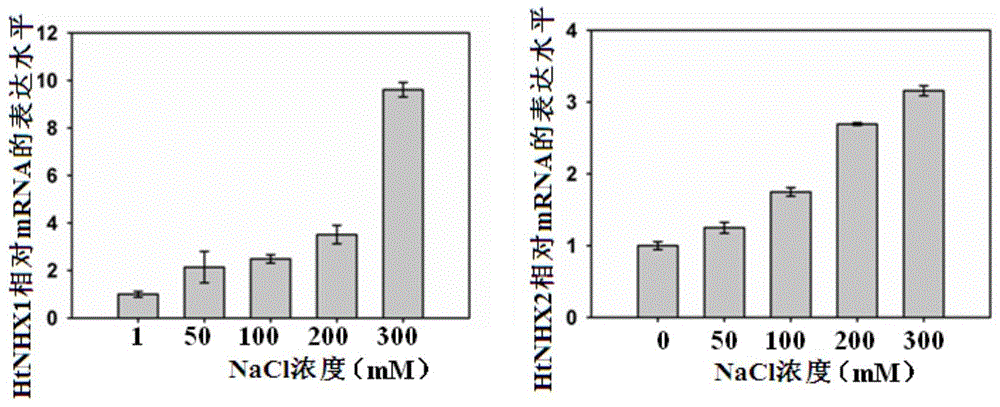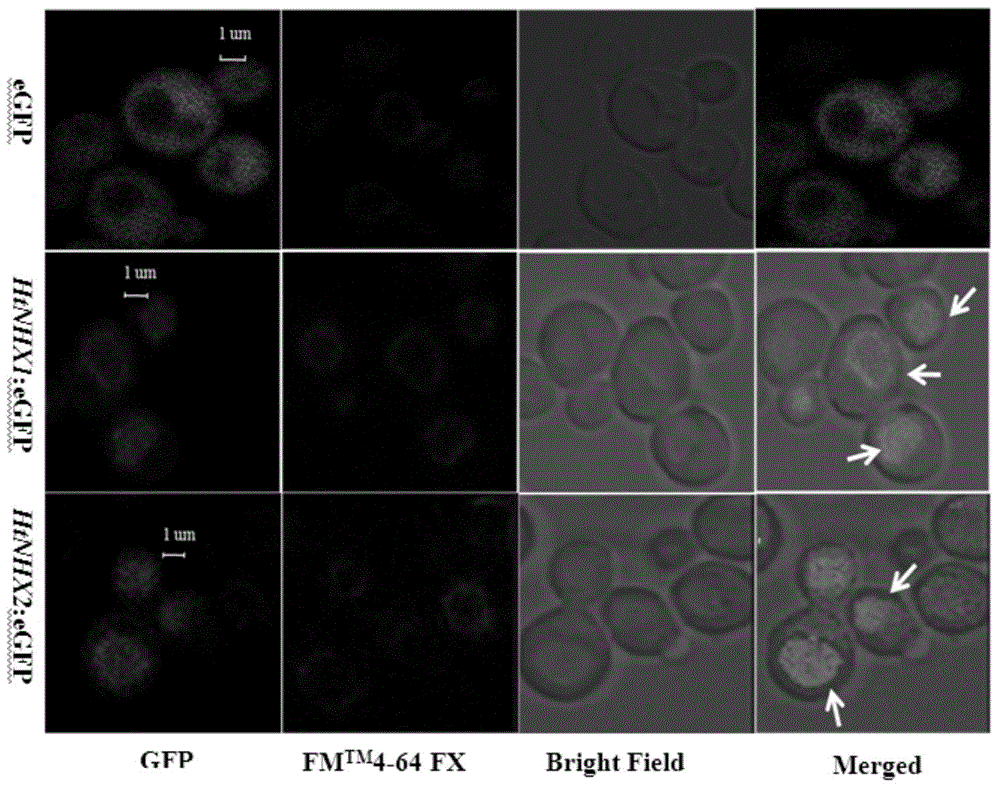Helianthus tuberosus L. Na<+>/H<+> reverse transport protein genes HtNHX1 and HtNHX2 and use thereof
An anti-transporter, Jerusalem artichoke technology, applied in the field of genetic engineering, can solve the problems of weak salt tolerance, low activity, and no improvement of the salt tolerance of Arabidopsis thaliana, and achieve the effect of improving the salt tolerance
- Summary
- Abstract
- Description
- Claims
- Application Information
AI Technical Summary
Problems solved by technology
Method used
Image
Examples
Embodiment 1
[0032] Cloning of Example 1 HtNHX1 and HtNHX2 Genes
[0033] (1) Using the cDNA of Jerusalem Artichoke No. 1 as a template, according to the plant tonoplast-type Na + / H + Design a pair of degenerate primers P1 and P2 for the homologous sequence of the antiporter gene;
[0034] (2) Using the cDNA of Jerusalem artichoke leaves treated with 200mM NaCl for 24h as a template, a fragment of about 400bp was amplified by RT-PCR,
[0035] (3) According to the sequencing results and the primers provided by Invitrogen's Gene Racer Kit, design two pairs of nested PCR primers: 5' reverse specific primer P3, nested primer P4 and 3' forward specific primer primer P5, nested primer P6 obtained about 1190bp 5' end fragment and about 765bp 3' end fragment by RLM-RACE method. The complete cDNA sequences of HtNHX1 and HtNXH2 were obtained after sequence splicing;
[0036] (4) By designing the full-length sequence primers P7 and P8, and using the cDNA of Jerusalem artichoke 1 as a template, P...
Embodiment 2
[0038] Expression characteristics of embodiment 2 HtNHX1 and HtNHX2 genes in Jerusalem artichoke leaves
[0039] (1) Extraction of total RNA; after culturing with 1 / 2 Hoagland nutrient solution for one week, treat with nutrient solution containing different NaCl concentrations for 24 hours, and then take about 0.1g of leaf samples to extract their RNA;
[0040] (2) Synthesize cDNA with a reverse transcription kit;
[0041] (3) RT-PCR and qRT-PCR; through the expression analysis of HtNHX1 and HtNHX2 in Jerusalem artichoke leaves, it was found that the expression of these two genes in leaves increased with the increase of NaCl concentration ( figure 1 ).
[0042] The primer sequences of the genes are designed in the following table:
[0043]
Embodiment 3
[0044] Example 3 Analysis of the subcellular localization of HtNHX1 and HtNHX2:
[0045] (1) According to the sequences of HtNHX1 and HtNHX2, we designed primers containing corresponding restriction sites (N-HtNHX F:
[0046] 5'-ATATAAGCTTAGATGCATGCTCGAGCGGCCGC-3' (SEQ ID NO. 21); N-HtNHX R:
[0047] 5'-TTATCCCGGGGTTTCCGGTGGTTTCTTCATC-3' (SEQ ID NO.22)), with HNHX1 or HNHX2 gene
[0048] The cDNA clone was used as a template to amplify the fragments of HNHX1 or HNHX2 without stop codon by PCR with high-fidelity enzyme KOD-Plus.
[0049] PCR products were recovered and purified by agarose gel electrophoresis and cloned into pEasy-Blunt vector. Positive clones were subjected to HindⅢ and
[0050] After SmaⅠ double enzyme digestion, it was connected to the intermediate vector pSAT6A-EGFP-N1 ( Figure 8 ), to obtain HtNHX1-GFP and
[0051] pSAT6A-EGFP-N1 vector for the HtNHX2-GFP gene. Respectively with the genes containing HtNHX1-GFP and HtNHX2-GFP
[0052] The pSAT6A-EGFP-...
PUM
 Login to View More
Login to View More Abstract
Description
Claims
Application Information
 Login to View More
Login to View More - R&D Engineer
- R&D Manager
- IP Professional
- Industry Leading Data Capabilities
- Powerful AI technology
- Patent DNA Extraction
Browse by: Latest US Patents, China's latest patents, Technical Efficacy Thesaurus, Application Domain, Technology Topic, Popular Technical Reports.
© 2024 PatSnap. All rights reserved.Legal|Privacy policy|Modern Slavery Act Transparency Statement|Sitemap|About US| Contact US: help@patsnap.com










